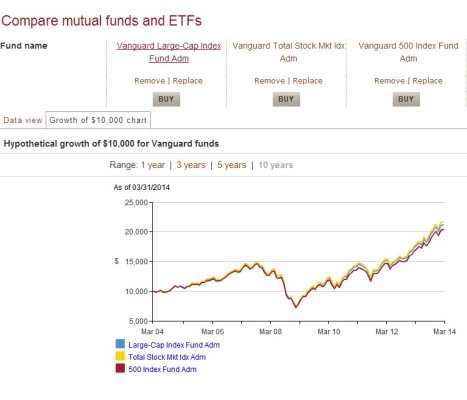Hi:
I currently have a sizeable amount of Vanguard S&P Index Fund (VFIAX) which makes up a good portion of my Large Cap asset allocation.
I read that something like 13 companies make up 25% of the weighted average of the S&P, and that an S&P index fund is not as diversified as you might expect across large cap stocks.
So, I am considering two alternative Vanguard Large Cap Funds. One is VTSAX and the other is VFIAX. I included some of their information below. Do you think, if part of my goal is to increase the diversification within my Large Cap asset allocation, that VTSAX or VLCAX would be a better choice? The expenses ratios are similar and the average returns for all three funds are not dramatically different. The VLCAX holds about 657 separate company stocks and the VTSAX holds about 3269 separate company stocks. Is there any reason I should stay with the S&P Index Fund?
Large-Cap Index Admiral Shares
VLCAX Stock - Large-Cap Blend 0.10%
Total Stock Market Index Admiral Shares
VTSAX Stock - Large-Cap Blend 0.05%
500 Index Admiral Shares
VFIAX Stock - Large-Cap Blend 0.05%
I currently have a sizeable amount of Vanguard S&P Index Fund (VFIAX) which makes up a good portion of my Large Cap asset allocation.
I read that something like 13 companies make up 25% of the weighted average of the S&P, and that an S&P index fund is not as diversified as you might expect across large cap stocks.
So, I am considering two alternative Vanguard Large Cap Funds. One is VTSAX and the other is VFIAX. I included some of their information below. Do you think, if part of my goal is to increase the diversification within my Large Cap asset allocation, that VTSAX or VLCAX would be a better choice? The expenses ratios are similar and the average returns for all three funds are not dramatically different. The VLCAX holds about 657 separate company stocks and the VTSAX holds about 3269 separate company stocks. Is there any reason I should stay with the S&P Index Fund?
Large-Cap Index Admiral Shares
VLCAX Stock - Large-Cap Blend 0.10%
Total Stock Market Index Admiral Shares
VTSAX Stock - Large-Cap Blend 0.05%
500 Index Admiral Shares
VFIAX Stock - Large-Cap Blend 0.05%

